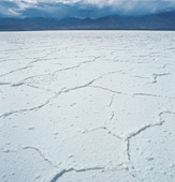
Chemical Sedimentary Rocks
Chemical sedimentary rocks form by precipitation of minerals from water. Precipitation is when dissolved materials come out of water.
For example: Take a glass of water and pour some salt (halite) into it. The salt will dissolve into the water. If you set the water in a hot and dry place (like Arizona) the water, but not the salt, will evaporate away. As the water evaporates, the concentration of salt gets higher and the water will eventually become saturated and will not be able to dissolve any more salt. At this point, as the water continues to evaporate, the salt will come out of solution and will be precipitated in the glass.
This is a common way for chemical sedimentary rocks to form and the rocks are commonly called evaporites. They are typically made up of the minerals halite (calcium chloride, or rock salt) and gypsum (calcium sulfate).
Another way to precipitate minerals out of water is to change the temperature (or the acidity) of the water rather than evaporate the water. This is how rocks such as limestones form. Limestones commonly form in oceans, which do not evaporate away. For example, when cold sea water heats up, it can no longer hold as much calcium carbonate (calcite, the mineral that limestones are made out of) in solution. When this happens, the calcium carbonate is precipitated out of the water as calcite, forming limestone. Limestones can also form from the shells of different sea critters that settle out on the bottom of the ocean.
 So, when we find a limestone, we know that there was a large lake or ocean present at that location in the past. When we find evaporites, we can tell that we were probably in a hot and dry environment such as a desert playa.
So, when we find a limestone, we know that there was a large lake or ocean present at that location in the past. When we find evaporites, we can tell that we were probably in a hot and dry environment such as a desert playa.

Halite, Gypsum Selenite, Limestone, and Limestone with sea creatures
| Previous Item: Clastic Sedimentary Rocks |
Go Up: Learn About Rocks |
Next Item: Metamorphic Rocks |

